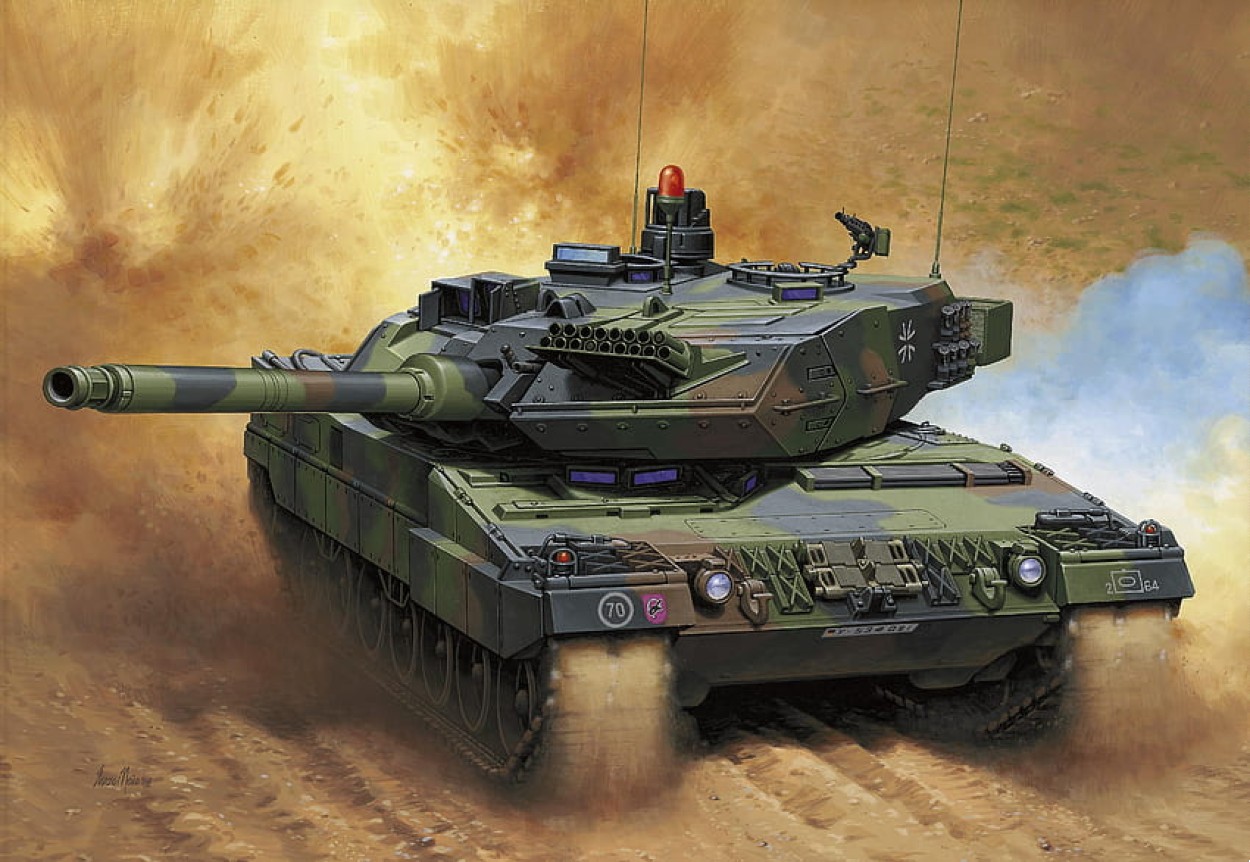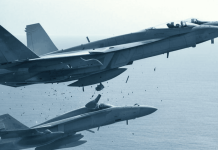German Leopards have overpowered US-made Abrams tanks in a highly competitive showdown, leading Lithuania to opt for them instead of their American counterparts.
Airframe With Zero Tech! Experts Decode N.Korea’s MQ-9 Reaper, RQ-4 Global Hawk ‘Duplicate Drones’
The Lithuanian government has set its sights on signing a letter of intent with Germany to acquire state-of-the-art Leopard 2 tanks for their Army, according to the Lithuanian Defense Minister Arvydas Anušauskas.
In addition to the German Leopard and the American Abrams tanks, the Lithuanian military also assessed South Korean Black Panther tanks during their evaluation process.
But the decision to acquire the German tank considers the comprehensive market analysis and military assessment conducted by the Lithuanian Armed Forces and the Defense Resources Agency.
Anušauskas highlighted that the military utilized several key evaluation criteria to determine their preferred vehicle. These criteria included price and maintenance costs, operational environment, mobility, safety, adaptability, protection, firepower, and interoperability.
The thorough assessment based on these factors allowed them to decide on selecting the most suitable tank for Lithuania’s land forces.
In his Facebook post, the minister explained (translated)
The Defense Resource Council of the Ministry of National Defense, taking into account the detailed market analysis and military evaluation performed by the Lithuanian Army and Defense Resource Agency, approved the proposal to submit to the National Defense Council a proposal to send a letter of intent to the German Ministry of Defense regarding the acquisition of Leopard tanks.
This proposal was presented at yesterday’s meeting of the State Defense Council, in which, in addition to the members of this council, the Chairman of the National Security Council, representatives of the URM, and other institutions also participated.
The main evaluation criteria on which the decision was made were cost and maintenance costs, the operational environment, mobility, protection, adaptability, protection, firepower, and connectivity. During this analysis, the Lithuanian Army has also assessed all possible threats and the necessary capabilities to counter such threats.
Lithuanian Army evaluated German “Leopard,” American “Abrams,” and Korean “Black Panther” tanks. The operational requirements raised by the Defense Headquarters of the Lithuanian Army are best met by Leopard, while tanks from the USA and South Korean manufacturers did not meet all the requirements.
An important argument was the spread of the tank – various versions of “Leopard” are spread among 23 countries worldwide, of which 14 NATO allies, such as Norway, the Netherlands, Germany, etc. Acquisition of Leopard tanks would ensure high interactions and compatibility with military units of Lithuanian partner countries, especially allies deployed in Lithuania.
For comparison, “Abrams” tanks are used by the USA, Poland, Arab countries, Taiwan, “Black Panther” – South Korea, and Poland.
Although the delivery dates of all rated tanks are similar (4-6 years), the ways of purchasing Leopard and Abrams are simpler and faster than others. Leopard and Abrams cost almost alike, but the big advantage of German tanks is the significantly lower maintenance cost. “Abrams” has 1.5 times higher operating costs.
Leopard adaptability is the best because all combat support vehicles (excavators, engineering vehicles, bridges) are on the same platform, which ensures good compatibility, facilitates logistic supply and preparation of mechanics.
At present, the Lithuanian Army already has German weapon systems in its armament: PzH2000 artillery, PKM Boxer (“Vilkas”), and combat evacuator BPz2. “Leopard” tanks would be best compatible with the military equipment currently used in the Lithuanian Army because they are the best compatible with the Lithuanian operational environment and natural and geographical conditions.
German company KNDS, which produces tanks and infantry fighting machines “Vilkas,” has established a service and repair center, “Lithuanian Defense Services,” in Lithuania, it performs the repair and technical service of PKM “Vilkas” and other German armaments. This center could also do Leopard tank repairs and maintenance.
The NATO Front Forces Battalion Group (eFP BG), deployed in Lithuania, which is led by Germany and regularly conducts military training and exercises with Lithuanian military units, is armed with Leopard tanks. Providing the Lithuanian Army with Leopard tanks would ensure high interaction and compatibility with this NATO unit, and in the future, a German brigade is constantly deployed with Lithuania.
Although the minister did not disclose the exact number of Leopard 2 tanks to be purchased, previous reports have indicated that the country’s military plans to acquire up to 54 tanks.
Furthermore, the defense minister also refrained from disclosing the estimated value of the planned procurement. This acquisition would undoubtedly enhance the country’s military readiness and further demonstrate its commitment to strengthening defense capabilities.
Lithuania’s move comes as other European allies have also been actively pursuing tank acquisitions in the wake of Russia’s invasion of Ukraine and escalating geopolitical tensions.
For instance, the Czech Republic also plans to acquire new Leopard 2A7+ tanks from Germany. It was reported that the Czech Republic’s armed forces are presently conducting tests on the first of the 14 used Leopard 2A4 tanks, which they are acquiring from Germany.
In a show of solidarity and cooperation, the Czech Republic had previously donated its T-72 tanks to Ukraine to aid the nation in countering the ongoing Russian invasion.
Through the “Ringtausch” program, Berlin then provided a batch of Leopard 2A4 tanks to Prague, allowing the Czech Army to bolster its combat capabilities.
The primary objective of this exchange is to modernize the Czech military’s equipment by replacing outdated Soviet weapons with state-of-the-art Western gear.
German-Made Leopard 2 Tank
The Kampfpanzer Leopard 2, developed and constructed by Germany in the 1970s, is one of the most extensively utilized tanks globally, with over 20 countries currently operating it.

The European countries are also supplying German tanks to Ukraine as part of their support in Kyiv’s counter-offensive operations against Russia. The 55-ton Leopard 2 is a formidable main battle tank, equipped with a 120-millimeter smoothbore gun and two 7.62-millimeter machine guns.
Operated by a crew of four, it runs on an MTU MB 873 12-cylinder, water-cooled diesel engine, producing 1,500 horsepower. With a remarkable ratio of 27 horsepower per ton, it achieves a top speed of 42 miles per hour, showcasing excellent battlefield mobility.
The Leopard 2 tank has been in service for over four decades, surpassing its original intended lifespan, a trend seen in many tanks worldwide.
Like the American Abrams tank, the Leopard 2 has demonstrated its adaptability to accept upgrades, ensuring its continued relevance on modern battlefields.
These upgrades encompass cutting-edge technologies such as active protection systems, GPS integration, programmable ammunition, and other advanced features, many of which were not even envisioned when the tank was first introduced in 1979.
Germany has exported Leopard 2 tanks to several countries, including Chile, Denmark, Finland, Greece, Hungary, Spain, Sweden, Switzerland, Turkey, Indonesia, Norway, Poland, Qatar, and Singapore.
The Netherlands has also exported these tanks to Austria, Canada, and Portugal. The Leopard 2 has seen limited combat. The German Army deployed it for peacekeeping in Kosovo, and Canada, Denmark, and the Netherlands deployed it in Afghanistan.
The Afghan-deployed tanks suffered mobility damage from mines but were restored to service. In contrast, Turkey’s 2nd Armored Brigade, equipped with Leopard 2 A4 tanks, faced losses during its engagement with Islamic State forces on its border with Syria, losing ten tanks to various causes.
- Contact the author at ashishmichel(at)gmail.com
- Article republished with minor modifications
- Follow EurAsian Times on Google News




